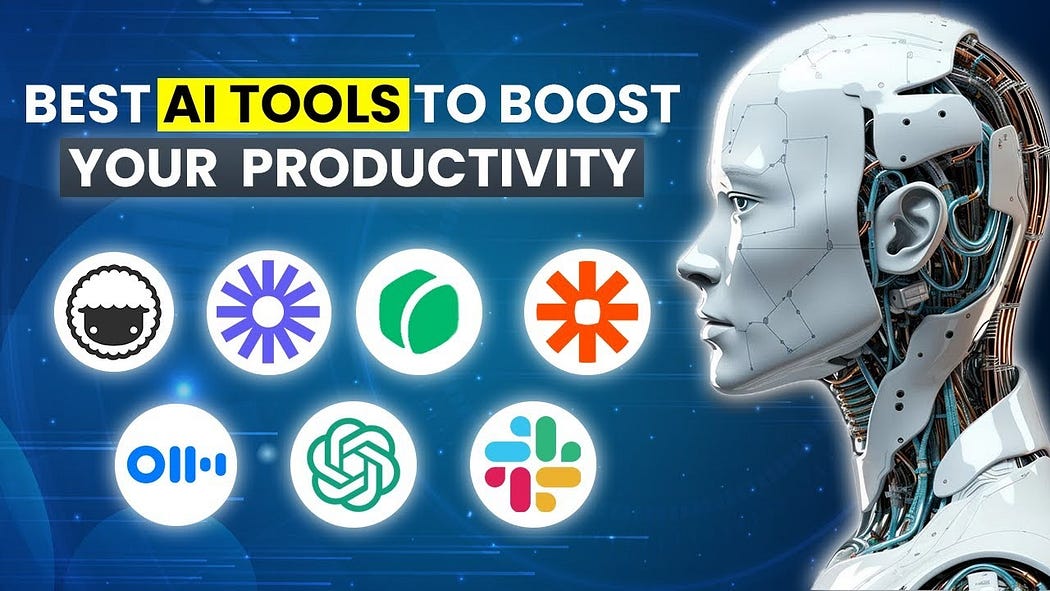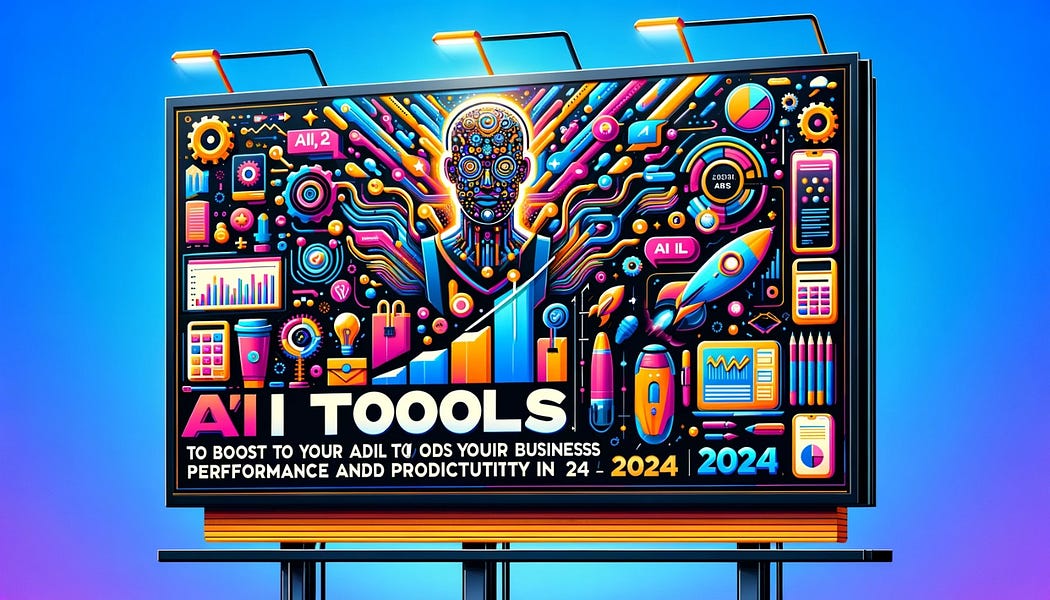101 SMART WAYS TO BENEFITS WITH AI TOOLS TO 10X YOUR PRODUCTIVITY IN 2024



101 SMART WAYS TO BENEFITS WITH AI TOOLS TO 10X YOUR PRODUCTIVITY IN 2024
Introduction
As we progress into 2024, the integration of Artificial Intelligence (AI) tools into daily workflows and personal lives is reshaping the landscape of productivity. From automating mundane tasks to enhancing decision-making processes, AI is revolutionizing how individuals and organizations operate. This guide explores the multifaceted role of AI tools, emphasizing their importance, future trends, ethical considerations, and strategies for effective implementation.
Overview
AI tools encompass a wide range of applications designed to perform tasks that typically require human intelligence. These tools can analyze data, automate processes, provide insights, and even generate content, thereby streamlining workflows and increasing efficiency. With advancements in machine learning, natural language processing, and robotics, AI tools are becoming more sophisticated and accessible to a broader audience.
Importance
The significance of AI tools in boosting productivity cannot be overstated. They help businesses and individuals:
- Save Time: Automation of repetitive tasks frees up time for more strategic activities.
- Enhance Decision-Making: AI can analyze vast amounts of data to provide actionable insights, aiding in informed decision-making.
- Improve Accuracy: By reducing human error in data handling and processing, AI tools can enhance the quality of outcomes.
- Personalize Experiences: In customer service and marketing, AI tools can deliver tailored content and recommendations, improving user engagement and satisfaction.
Future Trends
As we look ahead, several trends are emerging in the AI landscape:
- Increased Automation: More industries will adopt AI for automating complex workflows, including customer service, supply chain management, and human resources.
- AI in Personalization: AI will continue to refine personalization, making recommendations and services more tailored to individual user preferences.
- Integration with IoT: The convergence of AI and the Internet of Things (IoT) will enable smarter environments, where devices communicate seamlessly for enhanced productivity.
- Natural Language Processing Advancements: Continued improvements in NLP will lead to more intuitive human-computer interactions, enhancing the usability of AI tools.
Strategies for Implementation
To effectively integrate AI tools into workflows, organizations should consider the following strategies:
- Assess Needs: Identify areas where AI can add value, focusing on tasks that are repetitive, data-intensive, or require analysis.
- Choose the Right Tools: Select AI tools that align with organizational goals and user capabilities.
- Training and Support: Provide training to staff on using AI tools effectively, ensuring they understand the technology and its benefits.
- Monitor and Evaluate: Regularly assess the impact of AI tools on productivity and make necessary adjustments to optimize performance.
Ethics
The rise of AI tools brings ethical considerations to the forefront. Issues such as data privacy, algorithmic bias, and job displacement must be addressed to ensure responsible AI use. Organizations should establish ethical guidelines that govern the use of AI, focusing on transparency, fairness, and accountability.
Causes of AI Adoption
Several factors contribute to the widespread adoption of AI tools:
- Technological Advancements: Breakthroughs in machine learning and data processing capabilities make AI tools more efficient and reliable.
- Business Needs: The demand for increased efficiency and cost reduction drives organizations to explore AI solutions.
- User Acceptance: Growing familiarity and comfort with technology encourage individuals to adopt AI tools in various aspects of life.
Effects of AI Tools
The implementation of AI tools has both positive and negative effects:
Positive Effects
- Increased Efficiency: Automation leads to faster completion of tasks.
- Cost Savings: Reduced operational costs through efficient resource management.
- Enhanced Creativity: AI can assist in generating ideas and content, fostering innovation.
Negative Effects
- Job Displacement: Automation can lead to job losses in certain sectors.
- Dependence on Technology: Over-reliance on AI tools may diminish human skills and capabilities.
- Privacy Concerns: Increased data collection raises questions about user privacy and data security.
Solutions
To mitigate the negative impacts of AI tools, organizations can implement solutions such as:
- Upskilling Employees: Providing training for workers to adapt to AI-driven environments.
- Implementing Ethical Guidelines: Establishing clear ethical standards for AI usage to protect user rights.
- Promoting Human-AI Collaboration: Encouraging workflows where humans and AI complement each other’s strengths.
Regulation
The regulation of AI tools is essential to ensure their responsible use. Policymakers are beginning to draft regulations that address issues such as:
- Data Protection: Ensuring user data is collected, stored, and used ethically.
- Transparency: Mandating that organizations disclose AI usage and its impact on decision-making processes.
- Accountability: Establishing frameworks for holding organizations accountable for the outcomes of their AI systems.
101 ways to use AI tools across different productivity areas, from work automation to personal life, broken down into categories to give you actionable ideas for 10X productivity in 2024.
1. Work Automation
- Automate Task Scheduling — Use AI schedulers (e.g., Reclaim.ai) to optimize calendar management.
- Automate Email Responses — Tools like Lavender or ChatGPT plugins can generate responses and suggest tone adjustments.
- Expense Management — Automate expense logging with Expensify or Zoho Expense.
- Smart Data Entry — Use AI-powered OCR tools like Docsumo to automate data extraction from documents.
- Automate Document Formatting — Tools like ChatGPT can help quickly format documents to your desired style.
2. Enhanced Research
- Summarize Articles — Use ChatGPT or Summary.ai to condense research papers.
- Generate Research Outlines — Tools like Scite.ai help generate logical, research-backed outlines.
- Automate Literature Reviews — Use Connected Papers to organize academic paper research.
- Ask Experts in Real-Time — Leverage Elicit for Q&A with subject experts.
- Data Insights — Use Google’s AutoML for rapid insights from data-heavy research.
3. Content Creation
- Blog Post Drafting — Use Jasper AI or Copy.ai to quickly draft content.
- Generate Social Media Captions — Tools like Lately create captions tailored to social platforms.
- Video Editing Automation — Try RunwayML or Descript for AI-driven video edits.
- Automated Transcription — Use Otter.ai to transcribe interviews or meetings.
- Headline Generation — Headline AI can help create clickable, SEO-friendly headlines.
4. Sales Optimization
- Lead Scoring — AI tools like HubSpot analyze and score leads for better targeting.
- Personalized Sales Emails — Use Drift to generate personalized emails for different audiences.
- Automated CRM Updates — AI-based CRMs like Salesforce Einstein automate contact updates.
- Predictive Sales Analytics — Gong.io can analyze sales call data to identify high-value leads.
- AI Chatbots for Lead Capture — Tools like Intercom interact with visitors, boosting conversion rates.
5. Marketing & Branding
- Create Ad Copy Variants — Copy.ai or Writesonic can instantly generate multiple versions.
- Customer Segmentation — Tools like Segment use AI to identify customer groups.
- Product Recommendation — Use Dynamic Yield for personalized e-commerce recommendations.
- Predict Customer Churn — AI in ChurnZero identifies customers at risk of leaving.
- SEO Content Optimization — SurferSEO improves content ranking strategies.
6. Project Management
- Automated Task Assignment — Monday.com or Asana use AI to distribute workloads effectively.
- Generate Project Roadmaps — Use ChatGPT to draft actionable roadmaps from goals.
- Automate Time Tracking — Clockify can help track time spent across tasks.
- Risk Assessment — Use RiskLens for predictive analytics on project risks.
- Automate Status Reporting — AI tools can pull project stats and generate reports in real time.
7. Personal Productivity
- Habit Tracking — AI-based habit apps like Habitica gamify and optimize habit tracking.
- Meditation Reminders — Use Calm or Headspace for smart, mood-based reminders.
- Personalized Reading Recommendations — Perlego recommends books based on your reading habits.
- Automate Grocery Lists — Apps like Bring! can automate and update grocery lists based on shopping history.
- Voice-to-Text Notes — Use Voice or Notion AI to dictate notes and convert them to text.
8. Customer Service
- Automated FAQ Responses — Set up bots using Freshdesk to answer common customer questions.
- Sentiment Analysis — AI-driven MonkeyLearn identifies sentiment in customer feedback.
- Chatbot for 24/7 Support — Zendesk’s AI Chatbot provides consistent support, anytime.
- Email Query Prioritization — AI systems sort and prioritize incoming emails.
- Predictive Issue Resolution — Zoho Desk identifies and addresses issues before they arise.
9. E-Commerce
- AI-Powered Inventory Forecasting — Brightpearl predicts inventory needs based on demand.
- Product Photo Editing — Use Remove.bg to automate background removal in product images.
- Upselling Recommendations — AI in Shopify suggests relevant add-ons for customers.
- Automate Customer Reviews — Tools like Yotpo request reviews after purchases.
- Personalized Discounts — Dynamic Yield sets customized discount offers per customer.
10. Data Analysis & Visualization
- Automated Data Cleaning — Use Trifacta to clean and organize data for analysis.
- Quick Data Summaries — Use ChatGPT for summaries and insights from large datasets.
- Predictive Analytics — RapidMiner helps generate future projections.
- Dashboard Creation — Tools like Tableau AI create insightful visualizations on demand.
- Market Segmentation — Zoho Analytics identifies demographic segments in data.
11. Software Development
- Code Generation — GitHub Copilot assists in creating boilerplate code.
- Automate Testing — Use Testim.io for automatic code testing.
- Error Prediction — AI-powered Sentry predicts bugs and issues in code.
- Optimize Documentation — Document360 uses AI to streamline software documentation.
- Generate Code Comments — Tools like DeepCode create and optimize code comments.
12. Human Resources
- Resume Screening — Hiretual can scan and shortlist candidates based on criteria.
- Automated Interview Scheduling — Use Calendly or XOR for hassle-free interview coordination.
- Employee Onboarding — BambooHR automates the onboarding process for new hires.
- Employee Sentiment Tracking — Lattice measures workplace mood and morale.
- Predictive Retention — People.ai uses data to forecast employee turnover risk.
13. Creative Design
- Logo Generation — AI-based tools like Looka help create custom logos.
- Automated Color Palettes — Colormind creates smart color palettes.
- Smart Image Enhancement — Topaz Labs enhances photo quality automatically.
- Social Media Graphics — Canva AI generates ready-to-use designs.
- Product Mockups — Use Smartmockups for creating product demos instantly.
14. Education & Learning
- Personalized Study Plans — Tools like Quizlet customize study guides.
- Flashcard Generation — Anki uses AI to optimize flashcard repetition.
- Real-Time Language Translation — DeepL provides nuanced translation options.
- Tutoring Bots — Replika can act as a conversational tutor in various subjects.
- Smart Notetaking — Evernote AI helps organize notes intelligently.
15. Financial Management
- Budgeting Suggestions — Use Trim to monitor and suggest spending cuts.
- Investment Tracking — SigFig uses AI for investment recommendations.
- Automatic Bill Payments — Prism organizes and pays bills automatically.
- Expense Categorization — Tiller categorizes expenses for better tracking.
- Fraud Detection — Kount helps e-commerce sites prevent fraudulent transactions.
16. Healthcare & Wellness
- Smart Diet Planning — EatThisMuch suggests meal plans based on your goals.
- Symptom Checker — Ada uses AI to provide preliminary diagnoses.
- Fitness Routine Optimization — Apps like Freeletics adjust exercises based on your progress.
- Meditation Personalization — Insight Timer tailors meditations based on past sessions.
- Mental Health Monitoring — Woebot uses AI to track and improve mental health.
17. Event Planning
- Guest List Optimization — Eventbrite AI helps optimize attendee lists.
- Event Budgeting — AllSeated creates automated event budgets.
- Travel Arrangement Optimization — Kayak AI finds the best travel deals based on needs.
- Smart RSVP Management — Tools like Paperless Post track guest RSVPs automatically.
- Instant Venue Sourcing — Peerspace finds suitable venues for any type of event.
18. Legal & Compliance
- Contract Review — LawGeex automates contract review and identifies red flags.
- Case Research Summaries — Use ROSS Intelligence for legal case summaries.
- Compliance Monitoring — LogicGate manages compliance risks proactively.
- Document Authentication — Notarize provides secure document authentication.
- Data Privacy Audits — BigID scans and reports on data privacy issues.
19. Supply Chain Management
- Inventory Optimization — Llamasoft forecasts supply needs and optimizes inventory.
- Smart Warehousing — AI-driven GreyOrange improves warehouse logistics.
- Supplier Risk Assessment — Resilinc assesses supply chain risks proactively.
- Predict Delivery Delays — Tools like FourKites identify potential shipping issues.
- Demand Forecasting — Blue Yonder predicts market demand for better planning.
20. Personal Life
- Home Automation — Use Google Nest to automate lighting, security, and energy.
- Pet Care Reminders — Apps like PetDesk remind you of pet care needs.
- Voice-Controlled Reminders — Alexa or Google Home set reminders on command.
- Shopping List AI Suggestions — Use Basket AI to suggest items based on past purchases.
- Automate Personal Finance Tracking — Mint categorizes expenses automatically.
- Grocery Deal Finder — Basket finds the best local deals based on your list.
These AI tools can transform tasks in every domain, improving productivity across both professional and personal spheres for a highly efficient 2024!
Pros of AI Tools
- Increased Productivity: Automation and efficiency enhancements lead to higher output.
- Improved Decision-Making: Data-driven insights facilitate better choices.
- Scalability: AI tools can be scaled to meet growing business demands without proportional increases in costs.
Cons of AI Tools
- Job Displacement: Automation may lead to the loss of traditional jobs.
- Complexity: Implementing AI solutions can be complex and costly.
- Ethical Concerns: Risks associated with privacy, bias, and accountability.
Summary
AI tools are transforming productivity across various sectors, offering substantial benefits while also posing challenges that must be addressed. Understanding their importance, anticipating future trends, and implementing effective strategies for adoption are crucial for maximizing their potential.
Conclusion
The integration of AI tools into our professional and personal lives is not merely a trend but a significant shift towards a more efficient future. By embracing AI responsibly and strategically, we can harness its full potential to enhance productivity and create innovative solutions to contemporary challenges.
Thank You
Thank you for exploring this guide on AI tools and their impact on productivity in 2024. Embracing these technologies thoughtfully will empower individuals and organizations to thrive in an increasingly automated world.
This structure should provide a comprehensive overview of AI tools and their implications for productivity. If you need further details on any specific section, feel free to ask!


.jpg)
No comments:
Post a Comment